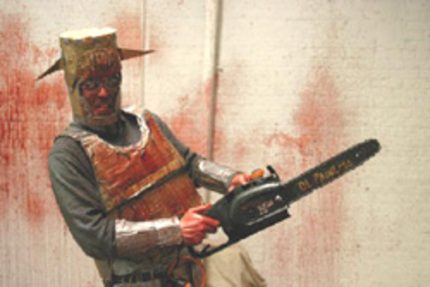Toronto After Dark 2007: Murder Party review

[Ah, my final submission from Toronto After Dark. Having had to work full time all week, take in two films per night and somehow miraculously pulled off a scheduling coup and gotten Saturday off to catch up on sleep and some writing, my time with TAD2007 comes to end. Kudos to the programming team. Not everything was a hit but then reactions to each film are subjective. I still had a good time this year and our posse of part-time critics continues to grow each year. Given enough time perhaps we'll take up an entire row soon enough]
Lonely New York Traffic Enforcement Agent Chris finds an invitation to a mysterious Halloween party taking place across town in the warehouse district. Rather than spend the night at home with only his cat, Sir Lancelot, too keep him company he decides to live a little on Halloween night and attend this party. Clad in his homemade cardboard knight’s costume, Chris ends up the unsuspecting guest of honor at the Murder Party. He’s tied up and tortured by a collective of pompous art students intent on turning his death into an art installation.
Eager to appease the tastes of their bourgeois benefactor Alexander our ensemble of suffering artistes get more wasted and the implements of artistic slaughter come out. Immediately they experience an accidental set back and as their own insecurities emerge they start turning on each other. Everyone dies in Jeremy Saulnier’s blood-soaked and sharp-witted dark horror/comedy Murder Party, ending in a bloodbath which literally gives the axe to the pompous New York art scene, while offering commentary about the rise and fall of society on the whole.
Murder Party proves that horror films can be intelligent and being horrific does not always mean that blood and guts have to fly. Anchoring on strong and sharp dialogue through most of the film Saulnier’s script exposes the irony and ugliness of the New York art scene, any art scene, and society as a whole for that matter. What we see is an aspect of society and a culture of one-upmanship that is ultimately hypocritical as success is beaten down. Whether speaking about a microcosm of society, in this case the art scene specifically, or, of a society in general that encourages creativity and social commentary only to tear it down when someone rises above the crowd with a singular voice or talent, Saulnier’s film speaks to the individual and the whole. When our collective of artists inject truth serum at the bequest of Alexander we begin to see that even inside their own group there rages a jealousy and hatred towards one of their own because he is more talented than the rest. And as their insecurities are exposed the only way they know to level the playing field is to tear down the esteem of one of their own. Then does the retaliation and resulting blunt force trauma begin and conclude with a blood soaked finale.
Chris, our unfortunate victim turned accidental hero is witness to this rapid degrading. Seizing moments as they present themselves he desperately tries to flee his captors at any opportunity. These moments are comically inspiring and display the sharp wit of Saulnier’s script. Chris is not really a hero. He’s just a simple guy caught up in a bad situation. When he gets his chance does he right the wrongs? Nope. He runs. Hell, he’s not a hero. He’s a guy who lives a low-key life who for once decided to live it up a little and got himself caught in this social breakdown. Only at the end of the film does that silver duct tape on his cardboard knight’s costume shine a little brighter and he brandishes that electric chainsaw, his Excalibur, and dispenses a little Arthurian justice on his pursuer. He didn’t care about the inner bickering of these supposedly social elite. He didn’t want to know who the better artist was and who would get Alexander’s grant money. He just wanted to party. And perhaps Chris should be held in higher regard than his pompous captors as even high culture and social standing couldn’t stop them from killing each other.
Murder Party will please both the intellectual and the blood hound, knocking one down a couple pegs and challenging the other to rise up. And perhaps the challenge there is for everyone to stand on equal ground. Also, did anyone catch the irony that it was video game in the end that stood out as the key influence to our rampaging killer? Isn’t it ironic in the sense that I wouldn’t think that a hoity-toity artist would think highly of the influence of a video game, of popular media, over art? Is it ironic that our killer wasn’t citing poetry, text, or humming Wagner symphonies while bludgeoning painted nude models? Instead he was quoting lines audible during game play. How would the art scene in New York feel about that?
On a side note, I spent my last two years of high school taking art classes with comic book artist Steve Skroce. Steve went on to do a few book titles here and there, even storybooking the Matrix films, I Robot and Speed Racer. I was a pretty good artist myself once. He's now successful and I am not. I’ve got a couple days until Halloween to make up my own invitations, rent a warehouse, print up cardboard knight costume designs and get my electric chainsaw.
After all, all I want to do is party.







